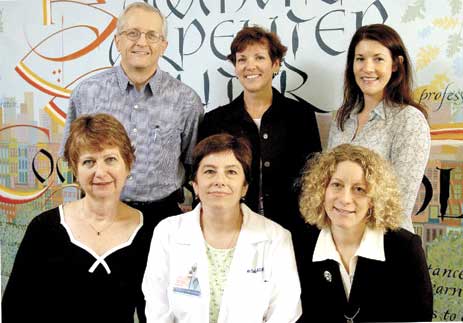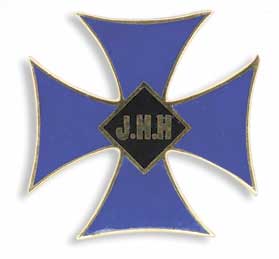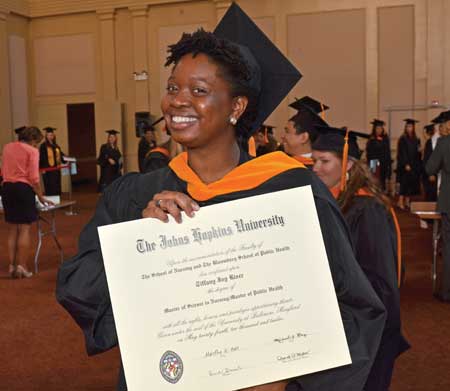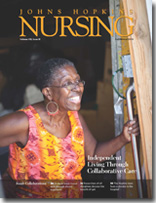Nightingala Raises More than $270,00
Howard Hughes Fellows Gain a Taste for Research
Faculty News
Global Connections
Honoring Diversity
Giving a Hand to Violence Prevention
Letters to the Editor
The Digital Hospital
Nightingala Raises More than $270,000

The spirit and music of John Denver lived on as a sold-out crowd filled Hopkins’ Peabody Concert Hall in June to enjoy a concert in Denver’s honor. The concert was held as the School of Nursing’s fifth Nightingala, a fundraising event sponsored periodically since 1994 for friends and supporters of Johns Hopkins Nursing to benefit the school’s community health programs. This year, by evening’s end, more than a quarter million dollars had been raised.
For Nightingala 2004, the School of Nursing partnered with the M.U.S.E. Foundation Inc. to produce “A Musical Tribute to John Denver.” The foundation, whose acronym stands for “Music Unites the Soul of Everyone,” produced Denver’s final major concert in Baltimore in 1997. Kenn Roberts, founder of the M.U.S.E. Foundation, felt the tribute was fitting. “As our fundamental mission is to use our love of music as a ‘force for good,’ it felt natural to bring John’s former band members together in Baltimore to help raise significant dollars for this worthwhile cause,” said Roberts, adding that the amount raised—substantially more than an initial $100,000 goal—is nothing short of remarkable.
Melissa Stark, NBC national correspondent for The Today Show, hosted the concert. Former John Denver Band members and colleagues joined the stage with members of the local band The Hard Travelers to perform folk, country, and bluegrass music. The impressive array of artists included Mack Bailey, Bill Danoff, Ira Gitlin, Jim Horn, Chris Nole, Kenn Roberts, Jim Salestrom, John Sommers, and Mollie Weaver. In the spirit of John Denver, a Peabody string quartet performed some pieces with the musicians. Prior to the concert, guests gathered in Peabody’s library for a VIP reception and silent auction. During intermission, a live auction of a watercolor of a Colorado mountainscape painted by Linda Roberts garnered an impressive $8,600.
All together the proceeds from Nightingala 2004 add up to more than $270,000—funds the school will use to provide quality nursing care to thousands of Baltimore’s uninsured and underinsured through five centers and several programs operated by nursing faculty and students.
— Ming L. Tai
Howard Hughes Fellows Gain a Taste for Research

Thanks to a $2.2 million grant from the Howard Hughes Medical Institute, two sophomores from Coppin State University spent the summer conducting research alongside distinguished faculty at the Johns Hopkins School of Nursing.
Leia Osbourne and Dara Foster were two of the 36 Howard Hughes Summer Research Fellows at Johns Hopkins University for 2004.
The grant funds a variety of programs, including the fellowship. Talented undergraduates from Hopkins and four other universities are chosen based on their academic record and research interests, and then matched with Hopkins researchers from the schools of Arts and Sciences, Engineering, Medicine, Nursing, and Public Health.
“We’ve had lots of wonderful students who’ve done wonderful things,” says Gary Ostrander, PhD, Hopkins’ associate provost for research. “They’ve gone on to some of the best graduate schools in the country.”
In the 11 years that the university has had the grant, the School of Nursing has had only a handful of Howard Hughes fellows. This year, Osbourne and Foster, who entered Coppin’s nursing school this fall, both expressed research interests matching those of Hopkins nursing faculty.
Osbourne was interested in pediatrics and forensic nursing. Over the summer, she worked with Dan Sheridan, PhD, RN, CNS, assistant professor and forensic clinical nurse specialist, and Shiprah A. Williams-Evans, PhD, APRN, BC, of North Carolina A&T State University.
Sheridan and Williams-Evans are starting a study on the barriers that battered women face in leaving their abusive relationships. They plan to survey women at three sites in Baltimore: the sexual assault emergency unit at Mercy Hospital; the House of Ruth, a local shelter for female victims of abuse and their children; and the Sinai Hospital ongoing support group for women who have already left violent relationships. Osbourne applied to the internal review boards of the sites to get their approval to conduct the study.
“I came in knowing absolutely nothing about the research process,” she says. “Now I know a bit about how to write a research proposal and apply for a study.”
Foster worked with Jerilyn Allen, ScD, RN, FAAN,professor and associate dean for research, on the BEST (Beneficial Effects of Soy Trial) study. BEST tests the benefits of soy supplements for reducing cholesterol and relieving menopausal symptoms in post-menopausal women. Study participants not in the control group drink a daily shake containing soy for four months to determine the effect of soy on their menopausal symptoms.
Foster helped screen potential study participants over the phone and sat in on nutrition counseling sessions.
She says the summer changed her perception of clinical research.
“I thought research was in the lab. In this study, you’re actually out with the participants, consulting them. It’s a lot of work, but you just think about how it’s going to help keep people healthy and living longer.”
—Kristi K. Birch
Howard Hughes fellows Leia Osbourne (l) and Dara Foster spent the summer doing research with school faculty.
Faculty News
New Faculty Faces
The number of full-time faculty at the school grew by nine this summer, as several newcomers joined the ranks and other part-timers became full-time.
Cheryl Dennison, PhD, CRNP, now has a primary appointment with the School of Nursing as an assistant professor. She continues her work with the Johns Hopkins Center for Innovation in Quality Patient Care.
Hayley Mark, PhD, MPH, RN, a former post-doc, has joined the School of Nursing as an assistant professor.
Elizabeth (Ibby) Tanner, PhD, MS, RN, assistant professor, joins Johns Hopkins from the University of Alabama in Huntsville. She has a joint appointment with the School of Nursing and the Center on Aging and Health.
Veronica Njie, MS, joins the School of Nursing as a full-time instructor. She comes to Johns Hopkins from the Catholic University of America, where she is a doctoral nursing candidate.
Cynthia Carbo, MSN, RN; Dennis Jones, MSN, RN; Peg Haroth, MS, RN,C; Carol Libonati, MS, RN, CS; and Ellen Ray, MS, CNM, all previous part-time faculty at the School of Nursing, are now full-time instructors.

Diane Aschenbrenner, MS, RN; Kathy Kushto-Reese, MSN, RN; and Ron Berk, PhD, received the first annual Distinguished Fellows Presentation Award from the International Society for Exploring Teaching and Learning.
Kathleen Becker, MS, RN, CANP, received the State Award for Excellence for Nurse Practitioners from the American Academy of Nurse Practitioners; Marion D’Lugoff, MA, RN-CS, received the State Award for Excellence for Nurse Practitioner Advocate.
Anne Belcher, PhD, RN, FAAN, presented “Can Nurses Live Happily Ever After?” at the Nursing Conference 2004 at the Johns Hopkins Bayview Medical Center and “Can GI Nurses Live Happily Ever After?” at the Regional Pediatric GI and Nutrition Nursing Conference at the Children’s Hospital of Philadelphia.
Lori Edwards, MPH, RN, received a 2004 Maryland Association for Higher Education Outstanding Educator Award in the Faculty Category.
Sara Groves, DrPH, RN, and Sharon O’Neill, CRNP, were promoted to assistant professors; Cynda Rushton, DNSc, RN, FAAN, and Julie Stanik-Hutt, PhD, RN, CRNP, ACNP, were promoted to associate professors.
Lisa Kelley, MS, RN, was nominated for the Nursing Spectrum Nurse of the Year award and received an honorable mention for her work in community health.
Miyong Kim, PhD, RN; Daniel Sheridan, PhD, RN; and Leslie Mancuso, PhD, RN, have been named fellows of the American Academy of Nursing. They will be formally inducted into the academy at its annual meeting and conference in November.
Renee Milligan, PhD, RN, received the Linowes Leadership Award at the NBC4 studios in Washington, DC.
Robin Newhouse, PhD, RN, was appointed co-chair of Hopkins’ IRB-X, the institutional review board that reviews expedited and exempt applications.
Linda Pugh, PhD, RNC, FAAN, and Kathleen White, PhD, RN, were named with joint appointments as Clinical Nurse Specialists (CNS) at the Johns Hopkins Hospital. These are the first associate CNS appointments from the school to the hospital.
Cynda Rushton, DNSc, RN, FAAN, participated in the National Faculty Development Workshop sponsored by the Education Development Center Inc. (EDC). The conference, facilitated by the EDC’s Initiative for Pediatric Palliative Care and designed to incorporate ethics and interpersonal skills into the care of seriously ill children, was the first of its kind to include bereaved family members as co-faculty.
Julie Stanik-Hutt, PhD, RN, CRNP, ACNP, attained CCNS Certification as a Critical Care Clinical Nurse Specialist.
Kathleen White, PhD, RN, was named to the board of CareFirst Inc.
Global Connections
Nursing in Kosova
As the coordinator of continuing nursing education at the Ministry of Health in Kosova, Fekrije Hasani works hard to improve the quality of nursing care and public health in her country as it rebuilds after war and crisis. Her recent six-week stay in the United States with the Institute for Johns Hopkins Nursing will help her do that.
Hasani came to Hopkins in June on behalf of the Hope Fellowship Program, a project of the National Albanian American Council, to learn more about nursing in the U.S. Her goal: to take back what she learned here to help her develop and implement plans to retrain nurses and establish nursing education and practice standards in Kosova.
Prior to her visit, Hasani says she had ideas about what she needed to do in her country but wasn’t sure how to implement them. “My stay here helped me learn a lot about how to go about doing things. I saw how to work together as a team. Now I know how to make the work not just my program but our program.”
During Hasani’s time in the U.S., her hosts from the Institute took her to a baseball game and out for steamed crabs. The rest of her time was packed with nurse training sessions, courses, orientations, workshops, and meetings with nurse educators, all of which offered valuable information. “I am excited to take this knowledge back with me to share with my colleagues,” she says, “and to help me as I develop new projects.”
—MLT
Doctoral Nursing Education Comes to China
It’s official. In August, the schools of nursing at Johns Hopkins University and Peking Union Medical College (PUMC) launched a collaborative program to prepare Chinese nurses as leaders in their country’s higher education for nursing, nursing research, and health care administration. The joint JHU/PUMC program is funded by the China Medical Board and will bring to China and the Chinese health care system a nationally recognized doctoral-level model for nursing education.
Students will study at both schools of nursing before completing their China-based doctoral research in China. Graduates of the program are expected to remain in China and, in ongoing collaboration with Hopkins Nursing, to serve as nursing education faculty, researchers, and administrators.
The new program is a continuation of a long history of Hopkins’ collaboration in nursing education with PUMC. Since 1915, Hopkins physicians and nurses have worked with PUMC to bring the best of modern scientific medicine and nursing to China. From 1919 to 1925, the School of Nursing’s very own Anna D. Wolf served as PUMC’s superintendent of nurses and, after establishing a collegiate nursing education program, served as its dean from 1924 to 1925.
—Lynn Schultz-Writsel
Honoring Diversity
Tibetan monks, break dancers, African drummers and dancers, and artifacts from cultures near and afar. The school’s second “Honoring Diversity Week” last March featured these cultural delights and more, as students, faculty, and staff celebrated the rich diversity found within the school’s own walls.
“For months after the Diversity Week, people continued to have spontaneous dialogue in the halls, at the coffee bar, or in offices, about the need to increase our awareness of workplace diversity.”
— Lori Edwards, MPH, RN
The week coincided with Peace Corps Week and was sponsored by the school’s Returned Peace Corps Volunteer program, the Alumni Office, and the school’s Diversity and Cultural Competency Committee. Its purpose: to put faces on the various cultures that suffuse the school. According to student Aisling McGuckin, a Returned Peace Corps Volunteer, “We aimed to create a celebratory atmosphere in which to focus attention on issues of diversity in our school, so that they could become more than simply buzzwords and so that they would have a context in which to be addressed in the future.”
Each day of the celebration highlighted a different part of the world. “SON Passports” listed various activities and guided participants throughout the week. To start, Tibetan monks came to the school to create a mandala, which in Tibetan Buddhism is a palace that is contemplated during meditation. Visitors could watch as the monks worked throughout the day to build the mandala out of brightly colored sand. Many returned later in the day when the monks distributed small packages of the sand in a ceremony focusing on compassion.
Throughout the week, displays created by faculty, staff, and students showcased different ethnicities, sexual orientations, traditions, and religions. An art gallery displayed diverse collections of art, crafts, and photography, as well as personal artwork belonging to school members. Lunchtime presentations and discussions focused on Native American health, community health work in Haiti, and diversity in the workplace.
Closing ceremonies included performances by African dancers and drummers, who interacted with the audience and got many of them dancing; students from Jemicy, a school in Owings Mills for children with language learning differences, who wowed the audience with their break dancing; and singing by two rappers, one of them staff member John Shearin.
“For months after the Diversity Week, people continued to have spontaneous dialogue in the halls, at the coffee bar, or in offices, about the need to increase our awareness of workplace diversity,” says Lori Edwards, instructor and chair of the Diversity and Cultural Competency Committee. “To hear about the richness of the experience that was felt by everyone around the school was inspiring.”
Plans are under way for another Diversity Week next March, and for smaller diversity-related activities to be held throughout the year.
— MLT
Giving a Hand to Violence Prevention
 On May 3, 2004, nearly 300 faculty, staff, and students at the school lifted their right hands and recited 14 words: “I will not use my hands or my words for hurting myself or others.”
On May 3, 2004, nearly 300 faculty, staff, and students at the school lifted their right hands and recited 14 words: “I will not use my hands or my words for hurting myself or others.”
This simple pledge is the linchpin of the Hands Are Not for Hurting Project, a nonprofit violence-prevention organization based in Salem, Oregon.
Although initially marketed to schoolchildren, the Hands Project has taken its pledge of nonviolence—both verbal and physical—to businesses, places of worship, homeless and battered women’s shelters, prisons, and daycare centers.
Last fall, Lincy Gregory, a Hopkins nursing student, saw a poster for the project on the office door of Dan Sheridan, PhD, RN, CNS, assistant professor and forensic clinical nurse specialist. Sheridan has been involved with the program since its founding in 1997.
“I asked him, ‘Why can’t we do that here?’ ” Gregory remembers. She and Sheridan sent an e-mail requesting volunteers to implement the Hands Project at the school in the spring.
On May 3, four sessions for taking the pledge were held in the Alumni Association auditorium. Some classrooms also took the pledge. Participants first watched The Power of One, a 10-minute video from the Hands Project that covers the range of both physical and verbal violence: terrorism, school shootings, child abuse, domestic violence, and teasing and bullying. After reciting the pledge, they traced their hands on purple paper and signed their names. Volunteers helped cut out the handprints and hang them in the school.
Sheridan says he hoped the event would inspire students to take the Hands Project into the community, where it is needed most.
He got his wish. A couple of weeks later, nursing students incorporated it into their community health clinical rotation at Collington Square Elementary School in Baltimore. “It worked well with our sex-ed curriculum because we were teaching boundary setting. And violence is not part of a healthy sexual relationship,” says nursing student Paul Schwartz ’04.
Ann Kelly, the program’s founder and a self-defense specialist, says the simplicity of the pledge, the sense of unity created by people repeating it together, and the visual reminder of the paper hands are effective. “It’s not rocket science. I wanted to reach people of all ages with a simple message to stop and think before you say or do anything harmful,” she says.
Sheridan is more direct: “I know it’s hokey, and I don’t care that it’s hokey. It’s simple, and it works.”
—KKB
Letters to the Editor
Excellent Coverage of NPs
My compliments to Elizabeth E. Evitts for her article, “RX: Nurse Practitioners” [Spring 2004] and to the rest of your staff for this excellent issue on nurse practitioners. The writer captured life and times as well as vital contributions nurse practitioners are making at JHMI, and the potential they have to help alleviate the crisis in health care delivery. There is one correction to the article: 41 million, not billion, people are without health insurance. Thank you.
Dr. Loretta C. Ford
Wildwood, FL
Missed Opportunity
It was a pleasure to read about all the great work being done by faculty, alumni, students, etc. [Spring 2004] but disheartening to see no one of color (except for a few patients) depicted in the photos of the issue. I hope you know you are missing an opportunity to reach out to potential students and faculty.
Rose M. Mays, PhD, RN, FAAN
Associate Dean for Community Affairs
Indiana University School of Nursing
The Digital Hospital
By Karen Haller, PhD, RN
VP of Nursing and Patient Care Services, Johns Hopkins Hospital
On the night of June 1, 2004, an army of people gathered for dinner on the 5th floor of Hopkins Hospital. Close to 100 people reviewed the final plans for converting nine nursing units to a computer provider-order-entry (CPOE) system that will eliminate writing orders on paper, faxing them down to the pharmacy, and transcribing them onto the nurse’s medication administration record (MAR).
That night, between 7:00 pm and 7:00 am, 12,000 orders were entered into the new system. It felt as if the long-promised digital hospital had finally arrived. Over the next year, the system will be implemented throughout the hospital.
Since 1991, when the Institute of Medicine called for the elimination of paper-based patient records, progress has been slow. Only a handful of hospitals have achieved the goal. In most hospitals, orders are still written on paper.
While eliminating the paper chase is laudable, the real goal of CPOE is to reduce error and keep patients safe. CPOE does this by addressing some of the main reasons that medication errors occur. For example, the computer requires a complete order. This is accomplished by “forcing functions”—features that restrict the way the order can be entered and require that all fields (dose, route, etc.) be completed. The use of computers can also reduce errors made in calculations—for example, the calculation of an infusion rate by a nurse. An order entered in the computer can be automatically checked against the patient’s weight to ensure a correct dose. Computers can also check for interactions among medications, as well as individual contraindications such as a patient allergy. Computers eliminate the need for transcription—another link in the old-fashioned process where errors can occur. Now the order is simultaneously sent to both the pharmacy and the nurse’s MAR. And when the new order pops up on the nurse’s electronic MAR? Yes, it’s legible!
Collaborating to Identify Depression in Teens
Depression is a treatable medical illness.
That was the main message of the Multidisciplinary Approach to Adolescent Depression course offered for the first time during the January intersession last winter.
The course is a fresh collaboration between the Hopkins School of Nursing and the School of Medicine. Seven nurses and physicians from both schools taught the three-day workshop from a variety of disciplines: pediatrics, community health, and psychiatry. The workshop trained the students to become depression educators themselves, teaching adolescents via the Adolescent Depression Awareness Program (ADAP) curriculum.
Karen Swartz, MD, a psychiatrist at the School of Medicine, developed ADAP in 1999 after several years of speaking in high schools after suicides. “What always struck me was the total lack of understanding about depression as a medical illness,” she says.
At least five percent of adolescents suffer from depression, says Swartz. Suicide is the third leading cause of death in 15- to 24-year-olds, and undiagnosed depression is likely a factor. Adolescent depression often goes undiagnosed. Teenagers are not always comfortable expressing their problems to their parents. Unlike adults, depressed teens are more likely to act irritable than sad. “And teens just get a bad rap,” says Swartz. “If they’re moody or angst-ridden, that’s written off as just being a teenager.”
To fulfill the course’s practical requirement, the nursing students went into health classes at Baltimore-area schools and taught ninth-graders what they had learned.
“It’s nice to have our students doing service in the community and to work with people both at the School of Nursing and the hospital. It’s a great joiner,” says Janet Berg, RN, MS, CS-P, one of the nursing faculty who taught the workshop.
Nursing students Nicole Liske and Sara Angelino taught at Reservoir High School in Howard County, MD. “These kids could name more antidepressants than I could,” says Angelino. “They could brand-identify from commercials. But they needed to know what depression really is.”
Angelino and Liske used presentations, group discussions, and videos to reinforce depression as a legitimate illness. They compared depression symptoms with those of pneumonia, and explained the symptoms of clinical depression. They also created a “mood graph” and charted the extremes of depression as well as bipolar disorder. Students watched an ADAP video in which the same actor plays a character who isn’t clinically depressed, one who is, and one who has bipolar disorder. The high schoolers laughed at the bipolar character’s manic phase. “They were surprised to learn that it was serious,” Angelino remembers. “They thought, What’s wrong with being that happy?”
But at other times, the ninth-graders understood depression too clearly. During a movie about depressed teens, one student identified with the movie and was referred afterward to a school counselor.
Liske and Angelino both say they value the experience they had as health educators. “The impact that teachers can have on kids’ lives—that’s amazing to see firsthand,” says Liske.
— KKB
 Class News
Class News On the Pulse
On the Pulse On The Pulse Ranked #7 in Top 60 Nursing Blogs
On The Pulse Ranked #7 in Top 60 Nursing Blogs Your Time to Lead
Your Time to Lead Letters to the Editor
Letters to the Editor







